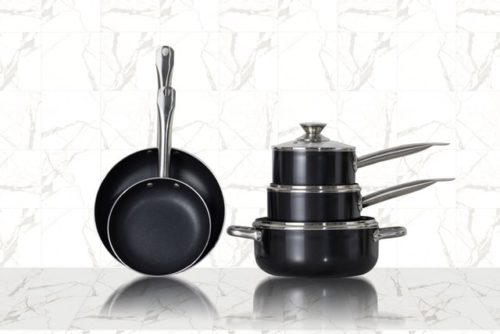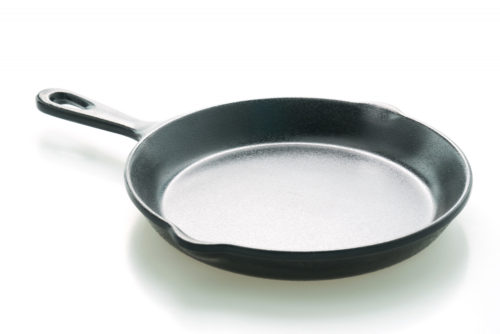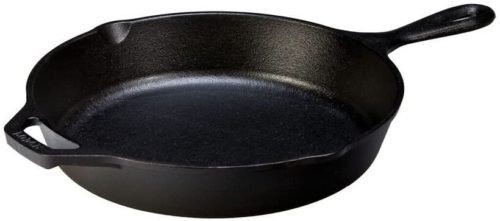Cast iron cookware outperforms every other cookware in terms of durability, heat retention, inherent non-stick properties, and cost. However, because cast iron cookware is heavy and needs upkeep or seasoning, not all meals may be cooked. Rust develops on cast iron due to improper maintenance.
What is cast iron?
Cookware of seasoned cast iron comprises 98 percent iron and 2 percent carbon alloy. Iron is melted in furnaces reaching 2,800 °F for all pots, skillets, and pans in one piece. The molten iron is then poured into molds lined with steel, pig iron, and metal scraps.
The metal is chopped, polished, and cleaned after cooling before even being “seasoned,” or oil-coated, and heated once again. Consequently, the cookware has a naturally nonstick surface that becomes better with use.

Benefits of Cast Iron
Chefs have historically chosen cast iron, but as health concerns regarding alternate nonstick cooking materials grow, it is making a comeback in domestic kitchens. While the safety of other cookware materials is a heated topic, cast iron offers several undeniable benefits.
Cookware weight
Cast-iron cookware’s substantial weight in this situation is both a benefit and a drawback. Because of the weight makes it suitable for camp cooking and sturdy, long-lasting, and adaptable to frying pans, pots, and skillets. There is also the matter of weight; cast iron is heavy, and there is no way around it.
Design
Shapes, sizes, and applications are available in a wide variety. Cooking implements include skillets, griddles, pots, Dutch ovens, and others. They all have robust bases, heavy lids, thick walls, and roomy handles for portability.
Non-Stick by Nature
A well-seasoned pan has a natural nonstick quality. But before adding the food, the pan has to be hot to be nonstick. A sticky situation will arise if, for instance, poached egg batter is added to a cold skillet and allowed to rest while the pan gradually warms up.
Cast iron may be protected by seasoning, making it easier to use. Chefs have a lot of disagreements over seasoning techniques, but they always include heating and lubricating the pan.
Even cast iron that has already been seasoned has to be seasoned before use. This is due to the increased nonstick properties of well-cast iron cookware.

Oven Safe
Cookware made of cast iron features handles made of cast iron, making it oven-safe. The handles are concurrently cooked and cast in one piece along with the saucepan or skillet.
A pan may be easily transferred from a stove top to an oven without melting or warping. Compared to most other cookware materials, cast iron is more heat-resistant.
Adds Iron
Food prepared in cast iron absorbs some iron throughout the cooking process. Even some doctors advise those with iron deficiencies to cook with cast iron.
Iron does move to food as it is cooked, but how much iron is transferred depends on the food being cooked, how old the pan is, and how it has been seasoned.
Cooking with cast iron is not the solution to low iron levels. However, every little thing matters as well. Acidic meals and food that has been cooked for a longer amount of time deposit the most iron.
Even non-acidic and fast-cooking items like eggs and hash browns generally had an iron level that was five times greater when cooked on an iron pan.
This is good news for women who are menstruating or expecting moms who need extra iron or have an iron deficit.
Cast Iron Skillet Sears to Perfection
When cooks need to sear or fry meat, they usually utilize cast iron pans because they can withstand high heat and radiate it. Cast iron is a typical work material for the same purpose.
Versatile
Seasoned cast iron pans work best for simmering, frying, searing, and stir-frying. They work well for roasting, baking, and slow cooking as well. You can cook anything from bread and desserts to eggs and bacon with cast iron.
Compatibility with Heat Sources
Cast iron cookware that has been thoroughly seasoned may be used on any type of burner, whether gas or electric, even on campfires and hot coals. The iron component of this cookware makes it appropriate for induction use. Cookware made of cast iron with handles built into it is safe to use in the oven and broiling.
Tolerance of High Temperatures
Cast iron can withstand temperatures up to 1500°F, making it perfect for open flame cooking. Keep in mind that the seasoning will be impaired once the temperature reaches 800 °F. After each usage, cast iron has to be gently seasoned.
Sautéing is best done in seasoned cast iron pans.
Cast iron is the debate among chefs about whether it evenly distributes heat when cooking and produces alleged hot spots. But everyone may agree that cast iron does a good job of holding heat. It warms up and remains warm.
Because cast iron has a high emissivity, heat spreads beyond the surface. This is extremely helpful when roasting meat or vegetables or making thicker fried foods like hash browns.
Cleaning
Even while cleaning cast iron might be difficult, it is the only type of cookware you can truly never destroy. If burnt debris is a concern, scrub the pot as thoroughly as possible with a chain mail scrubber or a metal scraper.
Although other burned pots can be cleaned, they can never be recovered to the same degree as seasoned cast iron. Your pot will function normally after you re-season it.
Safe
It’s important to keep in mind that while cooking, cast-iron cookware offers several benefits over other types of pots, pans, or skillets. Because no chemicals are used during manufacturing, there are few health risks.
Cast-iron cookware does not contain PFCs (polytetrafluoroethylene).
Originally employed to provide nonstick coatings for skillets and pans, PFCs are a class of chemicals that have now been linked to some very significant health risks.
Instead of being unglazed, modern cast iron is enamel-glazed, allowing you to experience stick-free cooking and simple cleanup without any added chemical hazards.
Affordable
Cast iron cookware might last a lifetime. Cast iron pans, entire cast iron pan sets, and barbecue pans are good methods to save money due to their extended lifespan.
Cast iron cookware has a far lower starting cost than other kitchen gadgets. Due to the ability to quickly recoup outlay costs, cast-iron pots and even enameled cast-iron are the greatest choices when shopping on a tight budget.
Care instructions for cast iron
Follow these four basic steps to care for your cast-iron cookware properly:
- Season it appropriately.
- Regularly clean it.
- Safely store it.
- Re-season it if necessary.
At first, glance, maintaining cast iron may seem like much more work than simply putting a skillet in the dishwasher.
After going through the procedure a few times, you could decide that the extra few minutes you spend maintaining your cast iron is worthwhile to have robust nonstick cookware that can be used repeatedly.
An outline of each process in maintaining cast iron cookware is provided below.
Season it appropriately.
Cast iron cookware can be “seasoned” to produce a naturally non-stick surface and corrosion resistance. It’s probably the most crucial phase in cast iron maintenance.
Cast iron can be seasoned with practically any cooking oil, but bear in mind that oils with strong flavors, like sesame or avocado, may flavor your cookware and the food you prepare.
Cleaning it frequently
Cast iron should be thoroughly cleaned after each use to avoid rust and preserve the nonstick finish. Cast iron tends to absorb tastes readily, making it more likely that the subsequent food you prepare won’t taste exactly like the one you just made.
Safely store it.
You must be confident that you have thoroughly cleaned and dried your cast iron pan before storing it to avoid rust.
Cast iron can be dried with a towel, heated in the oven, or even on the stovetop after being washed.
Re-season it if necessary.
No matter how well you take care of your cast iron, it will eventually need to be re-seasoned.
It also allows for a wonderful time to add a thin layer of oil and heat the pan to the oil’s smoke point to retain the nonstick coating if you decide to dry your cast iron with heat, such as in the oven or on the stovetop.
It’s time to re-season your pan if you start to see rust or notice that it’s becoming lighter in color.
Disclosure: This post contains affiliate links. As an Amazon Associate I earn from qualifying purchases, but there will be no extra charges to you. Thank you for your support!

